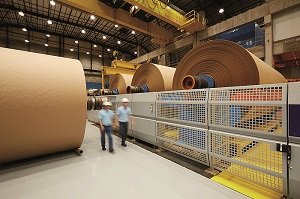Manufacturing is expected to be a major driver of economic growth in India — especially since the launch of Prime Minister Narenda Modi’s new campaign, ‘Make in India.’ The aim is to accelerate progress toward a new era of high-quality Indian manufacturing and transform the country into a global manufacturing hub. ‘Make in India’ is directed at developing the market and encouraging global investments, leveraging public-private partnerships and initiatives that improve the ease of doing business in India.

Rakesh Tripathi, director of strategy at MWV India tells Packaging South Asia that the Indian economy is expected to grow at 6.4% this year, and as it continues to return to higher single digit growth, manufacturing offers significant opportunities for job creation and economic growth. Among the many advantages of manufacturing in India are cost competitiveness and a sizeable working age population, but according to Barron’s, “A disproportionate share of labour works in agriculture, which contributes to around 15% to GDP. Services, which account for 60% of GDP, only employ one-quarter of the labour force.” This drive to grow manufacturing will employ more workers, contribute to the rise in disposable income and drive lifestyle changes for the average Indian citizen, Tripathi says.
Strong economic growth also indicates potential for an increased demand in higher-quality packaged goods. India is the world’s sixth-largest packaging market, valued at US$ 24.6 billion with a growth rate of more than 15% annually — more than double the global average which indicates a very strong future for packaging in India at least.
Tripathi says, “Our global Packaging Matters study data reveals that packaging plays a major role in product satisfaction for Indian consumers across every product category. Indian shoppers prefer to purchase products in-store, where the look and feel of packaged goods can sway consumer opinion. Packaging Matters shows that 65% have tried a product because the packaging caught their eye on the retail shelf, and more than half (55%) have purchased a product again because of its packaging.”
“At MWV, we are investing in our operations accordingly. The entire supply chain is crucial, and we believe that challenges in the pulp and paper sector can be overcome to enhance the performance of the box. Today, our manufacturing facilities in India are home to high quality corrugated paperboard and packaging for FMCG, automotive and engineering goods, fresh fruits and vegetables, household appliances, pharmaceuticals, and chemicals. Our new paper machine will bring a variety of new paperboard products and grades. This added capacity will enable us to develop high-quality solutions for the unique needs and scale of the Indian market,” he adds.
India’s retail market is the fifth-largest in the world and has been ranked as one of the top two most attractive for investments, according to a recent report by McKinsey. Packaging and retail go hand-in-hand, especially where eCommerce is on the rise. While online shopping is less common than brick-and-mortar, India is one of the fastest-growing eCommerce segments in Asia-Pacific. Today, eCommerce in India represents a value of around US$ 3.5 billion and is expected to quadruple by 2016. The burgeoning eCommerce industry has opened up new avenues for consumer packaged goods and by extension, for packaging. “We see significant opportunities for higher quality and more innovative packaging solutions in corrugated markets, and consumer categories such as food, beverage, healthcare and personal care — largely due to new retail channels and a fast growing middle class,” Tripathi concludes.











